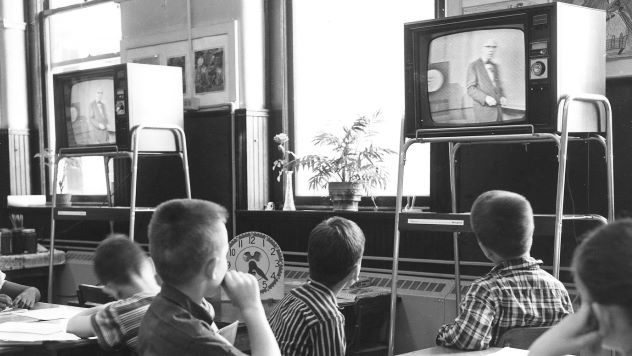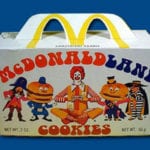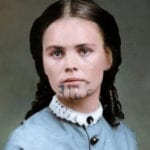 Mysteries
Mysteries  Mysteries
Mysteries  History
History 10 Surprising Stories About the Texas Rangers
 Humans
Humans 10 Philosophers Who Were Driven Mad by Their Own Theories
 Miscellaneous
Miscellaneous 10 Video-Game-Worthy Weapons and Armors from History
 Weird Stuff
Weird Stuff 10 Psychics Who Accurately Predicted Wartime Events
 The Arts
The Arts 10 Pieces of Art Inspired by a Broken Heart
 Health
Health 10 Science Fiction-Sounding New Medical Treatments
 History
History 10 Surprising Facts About the Father of Submarine Warfare
 Space
Space Ten Astonishing New Insights into Alien Worlds
 Weird Stuff
Weird Stuff 10 Bizarre Summer Solstice Rituals Still Practiced Today
 Mysteries
Mysteries Top 10 Haunting Facts About the Ghost Ship MV Alta
 History
History 10 Surprising Stories About the Texas Rangers
 Humans
Humans 10 Philosophers Who Were Driven Mad by Their Own Theories
Who's Behind Listverse?

Jamie Frater
Head Editor
Jamie founded Listverse due to an insatiable desire to share fascinating, obscure, and bizarre facts. He has been a guest speaker on numerous national radio and television stations and is a five time published author.
More About Us Miscellaneous
Miscellaneous 10 Video-Game-Worthy Weapons and Armors from History
 Weird Stuff
Weird Stuff 10 Psychics Who Accurately Predicted Wartime Events
 The Arts
The Arts 10 Pieces of Art Inspired by a Broken Heart
 Health
Health 10 Science Fiction-Sounding New Medical Treatments
 History
History 10 Surprising Facts About the Father of Submarine Warfare
 Space
Space Ten Astonishing New Insights into Alien Worlds
 Weird Stuff
Weird Stuff 10 Bizarre Summer Solstice Rituals Still Practiced Today
10 Popular and Unique Television Channels That No Longer Exist
Over the years, television broadcasting has proved vital across the globe. Millions of people watch television daily. The evolution of television made it the primary source of information and entertainment for everyone worldwide. Information and entertainment are pretty much what modern-day society is all about. Even with the rise of social media, television broadcasting keeps everyone up to date on the latest news, weather, and other important information in our daily lives. There is always something new to be informed on through the news, documentaries, and even commercials. Sports, movies, and comedy-featured content also serve as entertainment avenues to television viewers.
All this has been made possible with the emergence of various television channels throughout the years. Some of these channels remained in existence for decades, with quite a few rebranded over time. Unfortunately, others have also been brutally closed down or replaced by other television channels, having existed for a limited time. This list accounts for ten popular television channels that impacted television broadcasting—whether good or bad—even after being closed down.
Related: Top 10 Truly Terrible Television Series
10 Setanta Sports Channel, UK
Most English Premier League fans may very much recall Setanta Sports. The sports channel, founded in the United Kingdom, was bought by Eircom Limited (EIR) in 1992. Eircom was a telecommunication company based in Ireland that purchased the Setanta Sports channel to bring Irish sports to fans worldwide. The channel expanded to have operations all over the United Kingdom and was very popular by the end of 1998.
With the acquisition of Setanta, Eircom was able to expand its television coverage to more customers. Setanta acquired broadcast rights to American golf, English rugby union, boxing, and football. Setanta also made a big step in having the rights to the Scottish Premier League in 2004 and 46 Premier League matches from 2007 to 2010.
The channel appeared to be expanding rapidly despite facing fierce competition with Sky Sports during that period. However, the channel was bound to face problems because it borrowed millions of pounds to acquire the rights to particular sports matches. The UK-based company was on the verge of collapse, with a debt of around £250 million. Setanta was forced into bankruptcy in 2009 after failing to make payments for television rights, owing the English Premier League £30 million. As a result, several British football clubs faced financial difficulties during the 2009/10 season. The channel had to close down as it accumulated too much debt.
After Discovery purchased the Asian version of the channel, Setanta is still active in Eurasia. All other international versions of the television channel, including the UK-based ones, were purchased by various media companies. Sky Sports, however, continued to expand its brand and is now considered one of the best sports media outlets worldwide.[1]
Despite Setanta’s problems, it brought joy to football fans all over the United Kingdom.
9 The Comedy Channel & HA!
Although the world can never have enough laughter, it does not mean it requires two comedy channels. There were two comedy networks in 1989, which merged in April 1991. Home Box Office attempted to bring the chuckles 24 hours a day with the Comedy Channel, whiles Viacom had a similar idea, launching HA! about five months later in April 1991. Finally, both channels merged to form Comedy Central.
Before the channels merged, the Comedy Channel focused on stand-up comedy specials and clips from the classic comedy of feature movies. However, HA! produced content centered on acquired off-network situation comedies.
Both channels could not develop significantly during their years together, with only roughly seven million members apiece. According to the executives from both industries, the reluctance of cable system operators to take sides in a war between two industry giants was the reason for both channels not developing. Economically, the 50-50 marriage provided comedy television a 15 million-subscriber pool, nearly double the average starting capital. The merged television channels changed to Comedy Central, which is currently active and very popular among television viewers in the United States.[2]
8 HawkVision
HawkVision was a United States television channel that came to light in 1992. It was a short-lived television subscription service founded by Bill Wirtz, owner of the Chicago Blackhawks. The ice-hockey team never had their home games televised after the 1992 National Hockey League season as the Blackhawks owner believed broadcasting the home games would not be fair to season ticket holders.
Bill Wirtz decided to cancel all traditional broadcasting offers from various television channels and offer HawkVision as a television subscription service. The sole purpose for the existence of the HawkVision channel was to broadcast Blackhawks games from their Chicago stadium to the homes of fans for a fee of up to $19.95 per game. Wirtz kept HawkVision going after the Stanley Cup playoff games by offering access to regular-season home games for the next two seasons for a fee of $29.99 per month. The fans reacted angrily to the increase in price. It was unlikely anyone was going to pay that amount. The HawkVision television channel proved unprofitable after one season, as ticket sales figures dropped massively. Bill Wirtz passed on in 2007, which saw the home game television restriction removed.[3]
7 ITV Play
ITV Play was a British 24-hour participation television station that aired for a brief time. The channel lasted less than a year due to the infamous premium rate phone-in scandal that ruined it. When it was operating, it ran shows like The Common Room, The Debbie King Show, and the popular quiz show, Quizmania.
The television channel faced legal issues for charging people a lot of money to participate in the contests with very slim odds of winning. ITV set aside £5 million in its half-year results to deal with the financial fallout from the premium-rate phone-in controversy. The business had to pay for the Deloitte report and other inquiries into its phone-ins. As a result, the broadcaster announced in 2007 that it had set aside £18 million to cover the incident.
After that, all text and interactive voting on shows came to a close. Phone-in votings on the X-Factor show also ceased. ITV said on March 5, 2007, that all premium-rate phone competitions and quizzes, as well as the ITV Play channel, would be suspended. The ITV play channel closed down in the early hours of March 6, 2007.[4]
6 Men & Motors
Men & Motors was a lifestyle television channel in the United Kingdom. The channel, founded in 1996, focused solely on men who enjoy motors and ladies. Having a show full of cars and women back in the day was bound to draw millions of viewers. Men and Motors had numerous car content shows, fueled action movies, adult cartoons, and plenty of footage of scantily clad women.
Unfortunately, the lifestyle channel aired for less than a year on Freeview. The channel stopped broadcasting on digital terrestrial television to make way for ITV to establish ITV Play. Men & Motors was then only available on satellite and cable television because of the restricted bandwidth on the platform and a wish to retain the ITV family.
The channel was re-launched in 2012. Shane Lynch and Torie Campbell were the new hosts. A new revenue stream opened up for One Media, which purchased the rights to Men & Motors from Granada Television Products and ITV Digital Channels. The new channel has thrived as a YouTube offering, with 134 million minutes of viewing in 2020. It airs the best shows from the extensive archives in a new on-demand format.[]
You wouldn’t guess by looking at it now, but the Men & Motors channel was a force to be reckoned with when it was active.
5 Dumont Network
Dumont was one of the first major television and media networks in the United States. Columbia Broadcasting System (CBS), Dumont, and the National Broadcasting Company (NBC) dominated television in the United States during the 1940s. During the war, most television channels had sporadic television content. Dumont, on the other hand, devised a deal for advertisers. The network ran a midweek special, where sponsors and advertisers could use the Dumont labs for commercial purposes. Dumont Network was very ambitious compared to the other two major television networks. Every show took place inside the Dumont building, owned solely by the Dumont Corporation. The Honeymooners was among the show’s sketches, inspiring the popular CBS sitcom, Gleason.
Since Dumont lacked the financial resources of NBC and CBS, the network trailed behind those two in terms of star power and production quality after the 1940s. Dumont was placed fourth in the Nielsen ratings after American Broadcasting Company (ABC) and United Paramount Theaters merged in 1953. The Federal Communications Commission (FCC) limited the number of television stations an organization could possess and made it difficult for Dumont to expand the network. Dumont was on the verge of purchasing ABC and becoming the largest station in the United States until the FCC disapproved of the purchase. ABC, however, received financing from Paramount. Dumont converted to Ultra High-Frequency (UHF) broadcasts to save money. Unfortunately, no one liked UHF transmissions in the 1950s, resulting in the closedown of the channel.
The high cost of transmitting and the limit imposed by the FCC massively impacted Dumont Network and other television channels across the United States during the 1950s.[6]
4 Nuts TV
Television nostalgia buffs may recall a short-lived television channel in the United Kingdom that aired various fun and bizarre content. Nuts TV was a British television cannel that debuted in 2007. Unlike other failed stations, Nuts TV was available on the Freeview network. Despite promising a never-ending parade of bizarre content, it was unable to attract viewers. Nuts TV had celebrity hosts, Lucy Pinder and comedian Dan Wright hosting the shows on the channel. The evening content always had the same pattern. Each night began with news, followed by sports, girls, and sex-related content.
It was barely on our screens for two years, which was a shame. The channel presented a wide range of unique and fast-paced comedies. It also featured a bizarre segment in which Lucy Pinder, the famous model, read famous works of “literature” while dressed in lingerie. The channel aired 20 hours of live television every week on Freeview channel 42.
The Cable News Network (CNN) replaced Nuts TV. It was scheduled to premiere on Freeview in January 2009, pending approval from Digital Television Multiplex Operators Limited, which oversaw all Freeview channels. Unfortunately, the Nuts television channel became inactive in 2009, followed by the Nuts magazine five years later.[7]
3 The Cable Music Channel
The Turner Broadcasting System (TBS) owned the Cable Music Channel (CMC), a short-lived American cable channel. Ted Turner founded the all-music video channel, which debuted in 1984. With the Satellite News Channel going up against CNN back in the day, Ted turner wanted to give MTV a run for its money and music. But not all of his ideas turned out to be successful. While MTV had Madonna acting like a virgin on live television, CMC took a family-oriented approach. “I Love L.A.” by Randy Newman was the first video to air on CMC. Turner debuted the music channel with much excitement after his music video show, Night Tracks. However, with MTV still striving to expand its distribution, there was no room for a second music video network on cable systems.
Ted Turner decided to shut down the business after a month. The Cable Music Channel was sold to MTV’s parent company because it lacked the cable providers, videos, and viewership to compete with the all-music channel. The Cable Music Channel aired from October to November 1984. MTV, however, is now one of the leading entertainment channels worldwide[8]
2 Sumo TV
Imagine a world where you could create a platform and have users provide all of the content, such a bizarre world. Sumo TV debuted in 2006, claiming to be the first user-content television channel. Unfortunately, most people in 2006 did not have access to high-quality cameras or widespread internet access. This idea was quite astonishing because YouTube had only recently launched. But having a user-generated format could never work on broadcast television. It was one of the main reasons why Sumo TV failed.
Unsurprisingly, the channel faced a problem with the Office of Communications (Ofcom)—the British version of the FCC—for imposing broadcast regulations on the people who sent the clips. After ruling against two Sumo TV clips, Ofcom cautioned broadcasters about user-generated content.
Ofcom was concerned about the responsibility placed on creators for adhering to the Sumo network broadcasting code on the user-generated clips rather than the network performing adequate checks themselves. The channel officially closed down in 2012 and was replaced by the Horror Channel.[9]
1 National Educational Television

National Educational Television (NET) was an educational and public television network created in early 1952. The Ford Foundation previously owned it, and it was later co-owned by the Corporation for Public Broadcasting. From 1952 to 1972, the NET collection contained a lot of television programs on the humanities, public affairs, social issues, science, and education from non-commercial TV stations and producers. The channel aired documentaries and discussions on the black freedom struggle, the Vietnam War, the Cuban Missile Crisis, poverty, and student activism.
In 1963, NET decided to show documentaries that addressed issues regarding poverty and racism. The perceived liberal bias from the shows aired on the channel made it very unpopular with viewers. The Ford Foundation and the government decided to cease funding the television channel for continuously broadcasting such content. Within a year, the channel had lost so much money that it had to close down.
In 1970, the Public Broadcasting Service (PBS) replaced the educational channel, which initially began operations in 1969. The NET’s refusal to stop airing the critically acclaimed but contentious documentaries led to its closure by both Ford and the Corporation for Public Broadcasting in 1970.[10]








